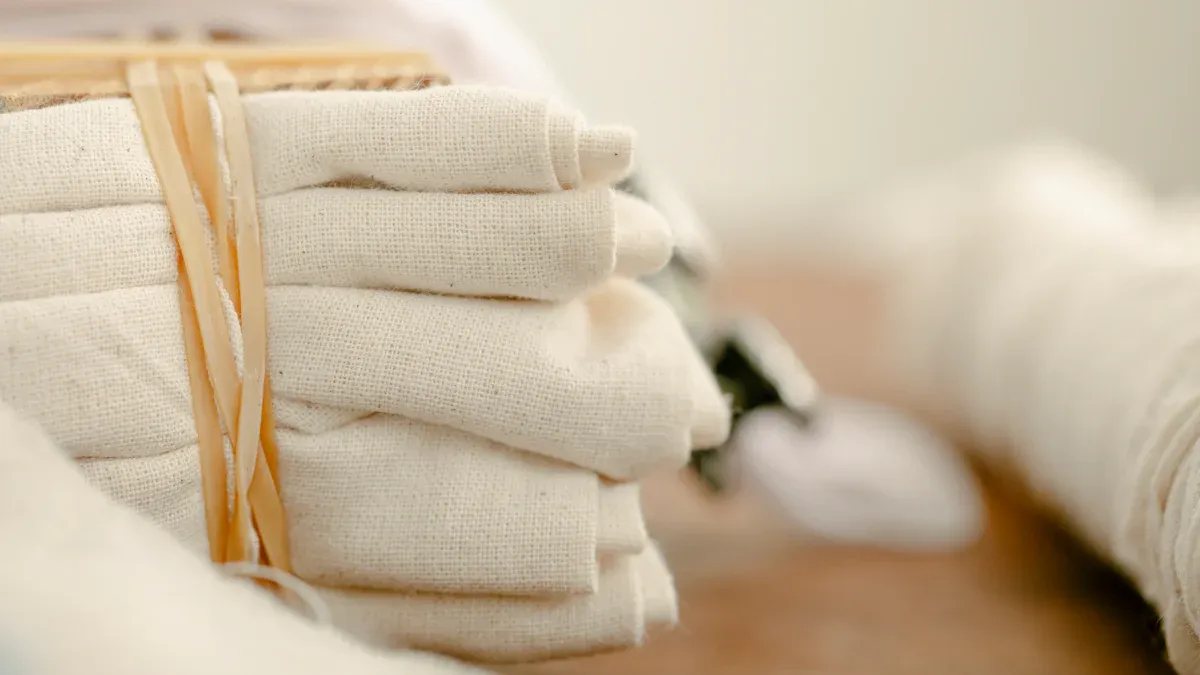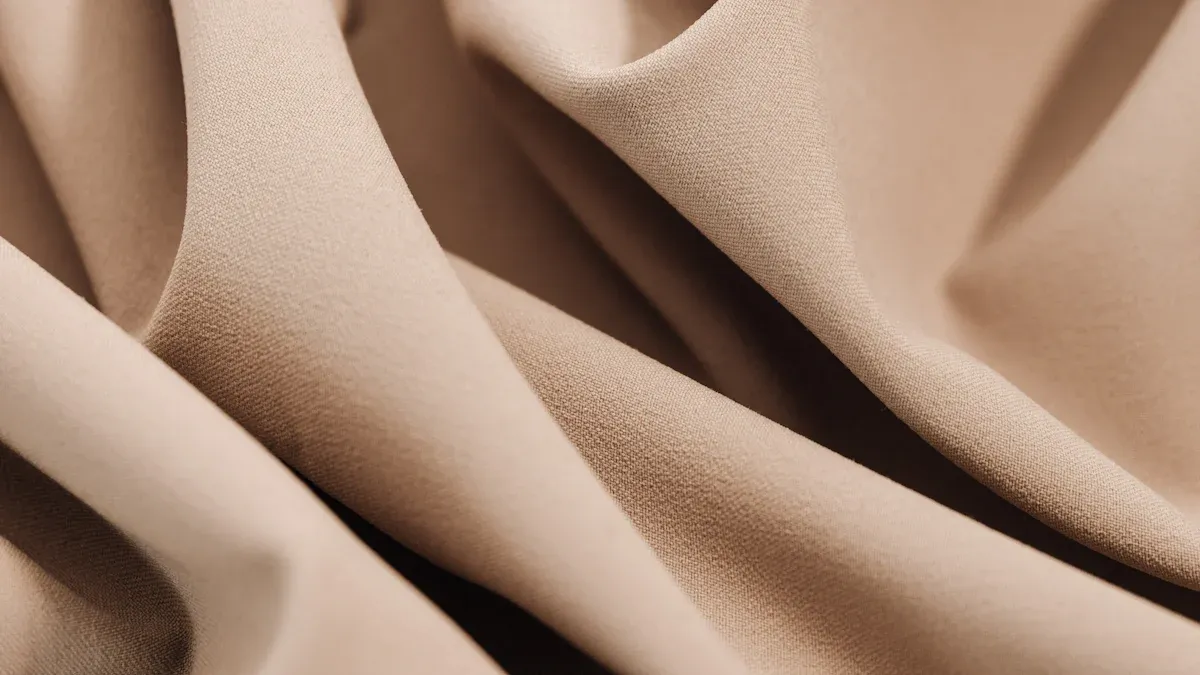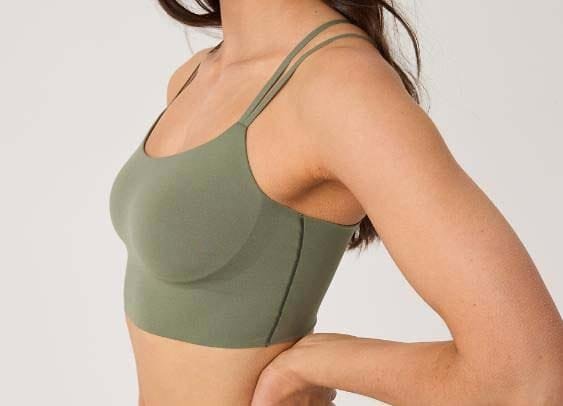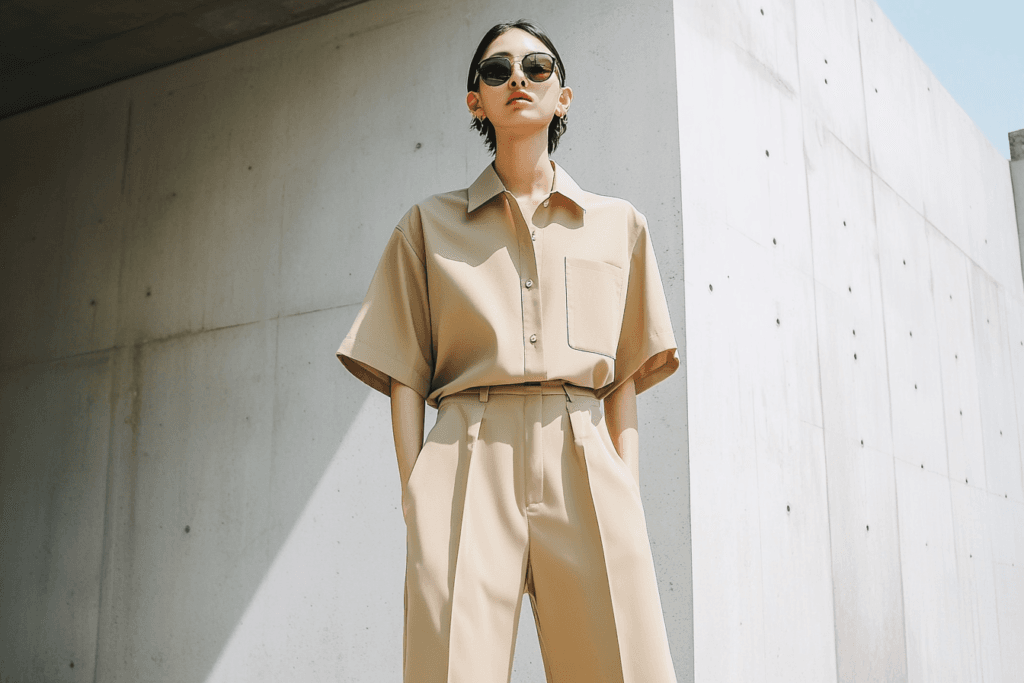
When talking about breathability, bamboo fabric is better than organic cotton. Its fibers absorb 60% more moisture and release heat faster.
This helps bamboo fabric keep you cooler in hot weather. Organic cotton is breathable, too, but it doesn’t remove moisture or control temperature as well as bamboo. Bamboo fabric is also around 20% more breathable than cotton. This makes it a good pick for staying comfy in humid weather.
Both fabrics are good, but bamboo’s fibers allow better airflow and moisture control.
Key Takeaways
- Bamboo fabric allows air to pass through more effectively than organic cotton.
- It keeps you cool and stops skin problems in hot weather.
- Organic cotton feels soft and is gentle on sensitive skin.
- Bamboo fabric dries sweat fast, so you stay comfy when active.
- Picking organic cotton helps the planet and saves water.
- Bamboo grows quickly and requires less maintenance, but the process of cultivating it can harm the environment.
- For sports clothes, bamboo is a great choice because it wicks away sweat effectively.
- Consider comfort, airflow, and the environment when selecting fabrics.
What Makes a Fabric Breathable?
Definition and Importance of Breathability
Fabric breathability means how well air and moisture pass through. This is very important, especially in hot or humid weather. Breathable fabrics help you stay cool by letting sweat dry and air flow. Without this, you might feel sticky and uncomfortable quickly.
Breathability isn’t just about feeling good. It also helps prevent skin issues like rashes or irritation. For example, Organic Cotton lets your skin breathe, making it great for sensitive skin. Whether you’re exercising or relaxing, choosing breathable fabrics is a smart idea.
Airflow and Moisture-Wicking in Fabrics
Two key things decide fabric breathability: airflow and moisture-wicking. Airflow is how easily air moves through the material. Loose weaves or open-knit fabrics allow more air, keeping you cooler. Tight weaves trap heat and sweat, making you feel hot.
Moisture-wicking means how well a fabric pulls sweat away from your skin. Fabrics with high moisture vapor transmission rates (MTR) do this better. For example:
| Aspect | Description |
|---|---|
| MTR | Shows how well a fabric lets moisture vapor pass. |
| High MTR | Keeps you dry and comfy by moving sweat away. |
| Low MTR | Traps sweat, causing discomfort and possible skin problems. |
| Fiber Structure Influence | Open-knit fabrics improve airflow, while tight weaves block it. |
Natural fibers like bamboo and Organic Cotton often have higher MTR than synthetic ones. This makes them more breathable and comfortable for daily use.
Testing Standards for Breathability (e.g., ASTM D737)
How do we measure breathability? Scientists use tests to check this. One common test is ASTM D737, which measures how much air passes through fabric. Results are shown in cubic feet of air per minute (CFM). Higher CFM means better breathability, while lower CFM means less.
Other tests check how fabrics handle moisture. For example:
- ISO 11092:2014 measures both heat resistance and water-vapor resistance.
- JIS L1099 uses the upright cup method to see how much water vapor passes through over time.
- Sweating Hot Plate (Ret) rates fabrics from “very good” (Ret 0-6) to “not breathable” (Ret 30+).
Here’s a simple table of test methods and their ranges:
| Test Method | Performance Range (g m−2 d−1) |
|---|---|
| Upright Cup Test | Low: <4,000, Moderate: 4,000 to 8,000, High: >9,000 |
| Inverted Cup Test | Low: <10,000, Moderate: 10,000 to 20,000, High: >20,000 |
| Sweating Hot Plate (Ret) | Ret 0-6: Very good, Ret 6-13: Good, Ret 13-20: Okay, Ret 20-30: Poor, Ret 30+: Not Breathable |
These tests help companies make fabrics for sports, work, or casual wear.

How Breathable Is Organic Cotton?
Fiber Structure and Air Permeability
Organic cotton’s fibers are soft and have tiny holes. These holes let air move through easily, keeping you cool. This makes organic cotton feel light and comfy in warm weather. It’s like wearing fabric that helps your body stay comfortable.
Studies show that air permeability depends on yarn flaws and fabric design. Here’s a table with some findings:
| Study Title | Focus | Findings |
|---|---|---|
| Fiber, Yarn, and Fabric Properties of Turkish Organic Cotton | Air movement and fabric traits | Yarn flaws affect how air moves through fabric. |
| Comfort Properties of Conventional vs. Organic Cotton Knitted Fabrics | Heat comfort in knitted fabrics | Organic cotton has better heat comfort than regular cotton. |
| Air Permeability and Light Transmission in Woven Cotton Fabrics | Air movement and fabric structure | Fabric design strongly impacts air movement. |
This shows how organic cotton’s fiber design affects breathability. Even small details, like yarn flaws, can change how airy it feels.
Weave Types and Their Impact on Breathability
The way organic cotton is woven changes how much air can pass. Tight weaves, like percale, trap air and feel less breathable. Loose weaves, like gauze, let air flow freely and feel cooler. Gauzy organic cotton is great for summer because it keeps you cool.
Tighter weaves work better in cold weather. They hold heat while still letting some air through. Picking the right weave for the season is important. When buying organic cotton, check the weave type for comfort.
Effects of Finishing Treatments on Organic Cotton
Finishing treatments can change how breathable organic cotton is. Some treatments, like dyes, block the fabric’s holes and reduce airflow. Organic cotton with fewer treatments feels more natural and airy.
Not all treatments are bad. Enzyme washes can make organic cotton softer and more breathable. These washes clean the fabric without blocking airflow. For the best breathability, choose organic cotton with minimal processing or labeled untreated.

How Breathable Is Bamboo Fabric?
Bamboo Viscose vs Bamboo Linen
Not all bamboo fabrics are the same. Two common types are bamboo viscose and bamboo linen. Bamboo viscose is made using chemicals, giving it a soft and silky feel. It’s lightweight and smooth, perfect for hot weather. Bamboo linen, however, is made mechanically, keeping the fibers more natural. This makes it rougher but also stronger and more breathable.
Bamboo linen feels cooler because its fibers are less packed. This allows more air to pass through. Bamboo viscose is breathable too but traps more heat due to its tighter weave. If you want maximum airflow, bamboo linen is better. But if you prefer softness, bamboo viscose is a great choice.
Moisture-Wicking and Thermal Regulation
Bamboo fabric is great at pulling sweat away and keeping you cool. Have you ever worn clothes that stick to you when you sweat? Bamboo fabric solves this by soaking up sweat and drying fast. This keeps you dry and comfy, even on hot days.
Studies show bamboo fabric absorbs water quickly. It beats polyester/cotton blends in managing sweat, making it ideal for activewear. Researchers found bamboo’s water absorption strongly links to its moisture-wicking ability (R² = 81%).
What does this mean? Bamboo fabric keeps you dry and helps control your body heat. It releases heat faster than cotton, keeping you cooler. Whether you’re exercising or relaxing, bamboo fabric helps you stay comfortable.
Comfort and Sustainability Benefits
Bamboo fabric isn’t just breathable—it’s soft and eco-friendly too. It feels smooth on your skin, almost like a second layer. It’s also hypoallergenic and antibacterial, making it gentle and odor-resistant.
Bamboo is also great for the planet. It grows faster than cotton or trees and needs less water and no pesticides. Here’s a comparison:
| Material | Yield per Hectare (tons) | CO2 Absorbed per Year (tons) | Oxygen Released (%) |
|---|---|---|---|
| Bamboo | 60 | 62 | 35 |
| Trees | 20 | 15 | N/A |
| Cotton | 2 | N/A | N/A |
Bamboo produces more per hectare and absorbs more carbon dioxide than trees. It also releases more oxygen, which helps the environment. Choosing bamboo fabric means picking comfort and helping the planet.

Which Fabric Works Best in Hot and Humid Weather?
Staying Cool and Dry
When it’s hot and humid, you need fabric that cools fast. Bamboo fabric is great for this. Its fibers release heat quickly, keeping you cool. It also absorbs sweat and dries faster than most fabrics. This means you won’t feel sticky or wet for long.
Organic cotton is breathable and lets air pass through easily. But it doesn’t pull sweat away as well as bamboo. If you sweat a lot, organic cotton might feel heavier and take longer to dry. Still, it’s a good choice if you like natural, untreated fabrics for warm weather.
Best Uses: Sports, Relaxing, and Work
Different fabrics suit different needs. Here’s a simple guide:
| Fabric Type | Best Use | Main Features |
|---|---|---|
| Bamboo | Sportswear | Wicks sweat, dries fast, breathable |
| Organic Cotton | Relaxing | Soft, airy, and comfy |
| Blends | Workwear | Strong, useful, and versatile |
For sports, bamboo fabric is the best pick. It keeps you cool and dry during exercise because it wicks sweat and dries fast. Bamboo shirts are perfect for summer hikes—they’re light and don’t stick to your skin.
For relaxing, organic cotton is super cozy. It’s soft and breathable, making it great for lounging at home. I love wearing an organic cotton hoodie on lazy weekends.
For work, fabric blends are a smart choice. They’re tough and practical but still comfy for long days.
Breathability Test Results
Curious about how these fabrics perform in tests? Here’s what I found. CleanBamboo beats bamboo viscose, TENCEL, and cotton in durability, sweat-wicking, and cooling. It’s one of the best for staying comfy and breathable.
In another test of over 30 bamboo sheets, breathability was a key factor. Bamboo fabrics scored high, proving they keep you cool and comfy.
Organic cotton also does well in breathability tests. But it doesn’t wick sweat as well as bamboo. If staying dry in hot weather matters most, bamboo fabric is the better choice.

What Are the Environmental Impacts of Each Fabric?
Organic Cotton: Water Use and Farming Methods
Organic cotton is much better for the planet. It uses up to 91% less water than regular cotton. Regular cotton farming needs a lot of water. For example, making one kilogram of cotton fabric takes about 10,000 liters of water. That’s like using 700 to 1,700 gallons of water for just one t-shirt!
Here’s a simple comparison:
| Metric | Regular Cotton | Organic Cotton |
|---|---|---|
| Annual irrigation water usage | Over 51 Trillion Liters | Uses up to 91% less water |
| Water required per kg | 2,068 liters | Much less |
| Percentage of organic cotton rainfed | N/A | 80% |
| Energy usage | N/A | 62% less energy used |
| Soil erosion | N/A | 26% less soil erosion |
| Carbon in topsoil | N/A | Three times as much as in atmosphere |
Organic cotton mostly uses rainwater, about 80% of the time. This saves freshwater and helps the environment. It also avoids harmful chemicals like pesticides, keeping soil and water clean. This is good for both nature and farmers.
Bamboo: Chemicals and Eco-Friendliness
Bamboo grows fast, doesn’t need pesticides, and uses less water. It sounds perfect, right? But turning bamboo into fabric can involve harmful chemicals. For example, bamboo viscose is made with carbon disulfide, which can harm nerves and health. Factories also use sodium hydroxide and sulfuric acid, which can irritate skin and lungs.
These chemicals can leak into the environment, polluting water and harming animals. Did you know the textile industry causes 20% of global clean water pollution? That’s a big problem. Bamboo linen is a better option because it’s more natural. However, it’s harder to make and less common.
If you want bamboo fabric, check how it’s made. Some brands are improving their methods, but there’s still work to do.
Certifications: OEKO-TEX vs GOTS
When buying eco-friendly fabrics, look for certifications. They show the fabric meets safety and environmental rules. Two important ones are OEKO-TEX and GOTS.
| Certification Standard | Description | Criteria |
|---|---|---|
| Oeko-Tex® | Checks fabrics for harmful chemicals and eco-friendly production. | Tests for harmful substances, updated yearly. |
| GOTS | Global standard for organic textiles. Requires at least 70% organic fibers. | Minimum 70% organic fibers, strict chemical and wastewater rules. |
OEKO-TEX ensures fabrics are free from harmful chemicals. GOTS goes further by requiring at least 70% organic fibers and strict processing rules. For organic cotton, GOTS is a great choice. For bamboo, OEKO-TEX ensures the fabric is safe to wear.
These certifications help you make better choices for yourself and the planet.

Which Fabric Is Better for Sensitive Skin and Comfort?
Hypoallergenic Properties of Organic Cotton
If you have sensitive skin, organic cotton is a great choice. Many people like it because it’s gentle and doesn’t irritate. Why is that? It’s hypoallergenic and free from harmful chemicals. Here’s why it’s special:
- Organic cotton is soft and airy, helping prevent skin irritation.
- It doesn’t have pesticides or synthetic chemicals, keeping it natural.
- Parents often pick organic cotton for baby clothes since it’s safe.
- People who care about health prefer it for its hypoallergenic qualities.
Tests for skin allergies show how important hypoallergenic fabrics are. These tests prove organic cotton is a smart pick for sensitive skin.
Antibacterial and Anti-Odor Benefits of Bamboo
Bamboo fabric is known for being antibacterial and odor-resistant. But is it really? Some tests show bacteria can still grow on bamboo viscose.
Bamboo fabric is soft and breathable, but its antibacterial claims aren’t always reliable.
Even so, bamboo fabric wicks sweat away, which helps reduce odors. I’ve worn bamboo clothes during workouts, and they stay fresh longer than others. Even if antibacterial claims aren’t perfect, bamboo is still comfy and breathable.
Preventing Skin Irritation and Heat Rash
Both organic cotton and bamboo help prevent skin irritation and heat rash. But they work differently. Here’s a simple comparison:
| Fabric Type | How It Helps with Skin Irritation and Heat Rash |
|---|---|
| Organic Cotton | Gentle, hypoallergenic, great for sensitive skin |
| Bamboo | Breathable, cooling, hypoallergenic; chemical processing may affect sensitivity |
Organic cotton feels soft and natural on your skin. It’s great for allergies or irritation. Bamboo is super breathable and keeps you cool. This makes it perfect for hot days when heat rash is a problem.
If you’re worried about chemicals, organic cotton is safer. But if you want something light and cooling, bamboo is a good option.

What Are the Cost and Availability Differences?
Market Prices and Affordability
The prices of organic cotton and bamboo fabric differ a lot. Organic cotton is usually cheaper than bamboo fabric, especially in bulk. This is because organic cotton has been made for a longer time. Its production methods are also more common. Products like organic cotton t-shirts or sheets often cost less than bamboo ones.
Bamboo fabric, however, is more expensive. Why? Making bamboo fabric, especially bamboo viscose, takes more steps and sometimes chemicals. Bamboo linen, which is more eco-friendly, costs even more because it’s harder to make. If you’re on a budget, organic cotton is a better choice. But if you can spend more, bamboo’s benefits might be worth it.
Supplier Access and Minimum Order Quantities
Finding suppliers for organic cotton or bamboo fabric can be tricky. Building good relationships with suppliers helps you get better deals. It also ensures you have enough fabric when you need it.
Minimum order quantities (MOQs) are important to consider too. They depend on the supplier and fabric type. For example:
- MOQs for organic cotton and bamboo fabric are often 10 to 50 meters.
- Some suppliers ask for bigger orders, especially for custom designs or colors.
- Sustainable fabrics like organic cotton and bamboo may have stricter MOQs due to special production needs.
If you’re new, find suppliers with lower MOQs. This lets you try out fabrics without buying too much at once.
Scalability for Small Brands and Startups
Growing production can be hard for small brands. Bamboo and organic cotton each have challenges. Bamboo is mostly grown in China, where large forests make harvesting easier. But in places like India, bamboo grows in smaller areas, raising costs.
Organic cotton has its own issues. In India, organic certifications make prices higher, which is tough for startups. In Vietnam, chemical use raises concerns about sustainability.
Here’s what I’ve noticed about scaling up:
- Machines in China make bamboo harvesting faster, but manual work in Myanmar lowers yields by 30%.
- Bamboo grows well in rainy places like Brazil, where drip irrigation helps. But in Ethiopia, lack of water makes scaling harder.
- Government rules matter too. China’s subsidies help bamboo farming grow, but Indonesia’s laws slow down processing.
For small brands, knowing these factors helps you plan better. If you want bamboo, focus on areas with efficient harvesting. For organic cotton, pick suppliers with certifications that match your values.
Scaling takes time, but with the right plan, it’s possible.
Both organic cotton and bamboo fabric have unique benefits. Organic cotton is strong, airy, and eco-friendly, especially when untreated. Bamboo fabric is great at pulling sweat away and keeping you cool, making it perfect for hot weather. But its chemical processing can harm the environment.
Here’s a simple comparison:
| Feature | Organic Cotton | Bamboo Fabric |
|---|---|---|
| Water Use | Needs less water than regular cotton | Uses less water than cotton |
| Strength | Very durable | Not as strong as organic cotton |
| Airflow | Very breathable | Breathable, depends on how it’s made |
| Eco-Friendliness | Fewer chemicals, supports nature | Chemicals may reduce eco benefits |
For sensitive skin, organic cotton is the best choice. For sports or humid days, bamboo fabric works better. In the end, pick based on what matters most—comfort, the planet, or performance.

FAQ
1. Which fabric is better for summer: organic cotton or bamboo?
Bamboo fabric is better for summer. It absorbs sweat quickly and dries fast. This keeps you cool and comfortable. Organic cotton is breathable but doesn’t handle sweat as well. If you sweat a lot, bamboo is the better choice.
2. Is bamboo fabric really eco-friendly?
It depends on how it’s made. Bamboo grows quickly and doesn’t need pesticides, which is good. But making bamboo viscose uses chemicals that can harm nature. Bamboo linen is more eco-friendly but harder to find.
3. Does organic cotton shrink after washing?
Yes, organic cotton can shrink, especially in hot water. To prevent this, wash it in cold water and let it air dry. Always check the care label for proper washing instructions.
4. Can bamboo fabric cause skin irritation?
Bamboo fabric is soft and usually safe for sensitive skin. But some people may react to chemicals used in bamboo viscose processing. Look for bamboo fabrics with OEKO-TEX certification if you have sensitive skin.
5. Which fabric lasts longer: organic cotton or bamboo?
Organic cotton lasts longer because its fibers are stronger. Bamboo fabric, especially viscose, wears out faster with frequent washing. For durable clothes, organic cotton is the better option.
6. Are bamboo and organic cotton fabrics good for babies?
Both are great for babies! Organic cotton is soft, breathable, and chemical-free. Bamboo fabric is also soft and cooling, perfect for warm weather. Make sure the fabric is certified safe for sensitive skin.
7. How do I know if a fabric is truly organic?
Check for certifications like GOTS (Global Organic Textile Standard). This ensures the fabric meets strict organic and eco-friendly rules. For bamboo, look for OEKO-TEX certification to confirm it’s free of harmful chemicals.
8. Can I use these fabrics for activewear?
Yes! Bamboo fabric is great for activewear because it absorbs sweat and dries fast. Organic cotton works too but is better for light activities since it doesn’t handle sweat as well as bamboo.
Related:
1.Best Bamboo Bedding in Canada: Eco-Friendly Comfort for Better Sleep →
2.Moisture Transmission Rate: Key Factors Affecting Breathability in Fabrics →
3.What is ASTM D737? →
4.Textile performance →
5.Breathability →
